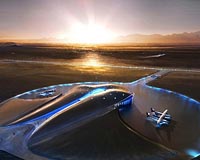 |
Bonn, Germany (SPX) Dec 23, 2009 January to April 2009: In January, the new DLR HALO (High Altitude and Long Range Research Aircraft) research aircraft landed for the first time at its home airport in Oberpfaffenhofen. The Gulfstream G550 was converted into one of the most modern aircraft for climate and atmospheric research and can fly higher and further than any previous research aircraft. In February: Congratulations Columbus! It is a year ago that the space shuttle Atlantis carried the European Columbus research laboratory to the International Space Station (ISS). Since then up to six astronauts have been conducting experiments there. Also in February, the European CoRoT space telescope discovered the smallest rocky planet outside our Solar System. In March, a virtual flight to Mars started in Moscow. For 105 days, six crewmembers simulated the isolation of a journey to Mars. The German Oliver Knickel was part of the crew. The experiment was intended to discover how astronauts could maintain their physical and psychological performance in the extreme situation of a flight to Mars. In April, the exhibition 'Out of this World - Wonders of the Solar System' opened in the Gasometer Oberhausen. The 'largest Moon on Earth' can be admired there, among other things. Also, DLR scientists have been using the Dornier Do 728 research aircraft for the last two years to study how passengers and crew feel most comfortable in the cabin. May to August In May, the European Space Agency (ESA) appointed six new astronauts, including the German geophysicist Alexander Gerst. At the first national robotics conference in Berlin, DLR presented current research results, new projects and their robot, Justin. In June, DLR researchers in Gottingen achieve project funding for a new and unique wind tunnel in which engines can be tested under realistic conditions. Also, the DLR A320 ATRA research aircraft taxied at Manching, near Ingolstadt, for the 'taxi vibration test'. This is done so that mobile vibration tests can be carried out on the aircraft; larger-scale stationary vibration measurements are no longer required. In July, the Antares DLR-H2 fuel cell aircraft took off from Hamburg. The motorised glider is the first aircraft in the world that can not only fly using a fuel cell but can also take off with it. Also, an Air Berlin crew tested a new landing approach system. In contrast to the current landing approach system, aircraft using the new system can approach an airport more steeply and also in a curve, something that can reduce noise significantly. In August, DLR exhibited at the Moscow MAKS Aviation and Space Salon. Also, the first solar tower power plant in Germany was officially inaugurated in Julich. September to November: Aerospace Day in September - more than 100,000 visitors showed their interest in the work of DLR and its partners in Cologne. A great public attraction was the A380, which landed at Cologne/Bonn airport for the first time. Also in September, the EXPERT 'rocket nosecone', which can not only survive re-entry into the atmosphere but can also collect data for future missions, was being completed. In October, the DLR Lampoldshausen site, which houses one of the leading test facilities for rocket engines, celebrated its fiftieth anniversary. The engines for the European Ariane rocket are tested there. Also, the vibration characteristics of the Solar Impulse solar aircraft were being tested by DLR researchers in Switzerland. In November, the free-piston engine was being tested at the DLR Institute of Vehicle Concepts. With reduced exhaust gases, this engine is more efficient than a hybrid engine. Also in November, DLR brought 100 years of Berlin history to life using aerial and satellite photos. Share This Article With Planet Earth
Related Links German Aerospace Center (DLR) The latest information about the Commercial Satellite Industry
 Centennial Challenges, Spaceport And Suborbital Science Receive Funds
Centennial Challenges, Spaceport And Suborbital Science Receive FundsWashington DC (SPX) Dec 23, 2009 NASA's Centennial Challenges prize program, FAA's Spaceports Infrastructure Grants initiative, and the new NASA Commercial Reusable Suborbital Research program (CRuSR) gained momentum after receiving funding in the NASA and FAA appropriations bills for Fiscal Year 2010, passed by Congress and signed by the President last week. The Commercial Spaceflight Federation conducted advocacy effort ... read more |
|
| The content herein, unless otherwise known to be public domain, are Copyright 1995-2009 - SpaceDaily. AFP and UPI Wire Stories are copyright Agence France-Presse and United Press International. ESA Portal Reports are copyright European Space Agency. All NASA sourced material is public domain. Additional copyrights may apply in whole or part to other bona fide parties. Advertising does not imply endorsement,agreement or approval of any opinions, statements or information provided by SpaceDaily on any Web page published or hosted by SpaceDaily. Privacy Statement |